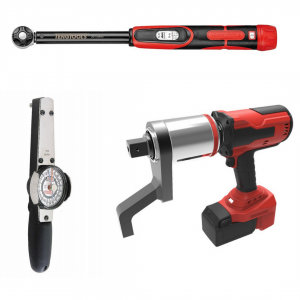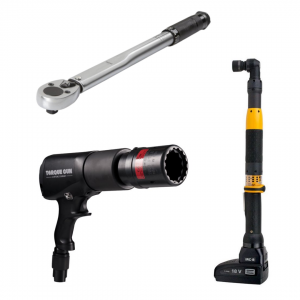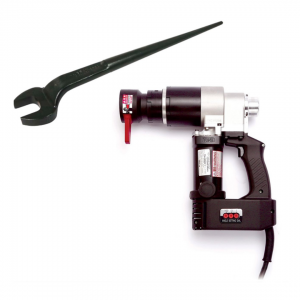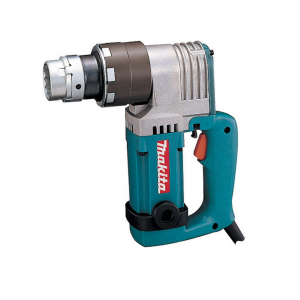BOLT TIGHTENING METHODS : THE PROS AND CONS
When assembling your product using a bolt and a nut, the process may seem more or less trivial. But is it really?
The answer is no!
Proper preloading of a bolted connection when required can be a difficult task. Insufficient preload due to an inaccurate tightening method can be a cause of bolted joint failure.
Tension, tension, tension!

All bolted joints are designed to achieve a specific tension and the tightening method is the vehicle that gets you to tension. The bolt acts as a spring to generate and retain preload in the joint. If the bolt is not stretched or elongated correctly, targeted preload cannot be achieved and maintained.
Several different tightening methods have been developed, such as:
• Torque Tightening
• Direct Tension Indicators
• Angle Tightening (Turn of Nut)
• Tension Control Bolting
Which is the best method to tighten a bolt?
Different methods are preferred depending on the market segment or the application and each have their specific advantages and disadvantages.
1. Torque Tightening
Torque is a rotation stress applied to the bolt head so that the bolt threads into the nut and compresses the plates of the joint. As the plates compress, the bolt elongates—The more stress is applied to compress and elongate, the higher torque is.
Applied torque has to overcome friction in order to generate clamping force or load.
Typically, 50% of applied torque is utilized just to overcome underhead friction and 40% to overcome thread friction.
The balance, or 10%, of applied torque generates load in the joint.

Tools
The simplest tool is the clicker wrench and it has an accuracy of +/- 4%.
Other electric, pneumatic, and manual tools are available. Impact tools are also available but they should be avoided.
Pros
When accurate tension is not critical, this is a fast, relatively inexpensive method.
Cons
This is not really a method to indicate tension, which can be greatly scattered due to inherent tool inaccuracy and then further compounded by frictional variations.
2. Direct Tension Indicators, Standard
DTIs provide a method to quantifiably confirm that the tightened fastener has generated the correct preload in the joint. Inspection is conducted with the appropriate feeler gauge or there is visual confirmation that the washer has been completely flattened.
Squirter® DTIs provide a “Squirt” visual indicator when the correct preload has been achieved.
The ironworker makes a visual judgment based on the appearance, flow volume, and number of Squirts to determine if preload is correct.
Inspection is visual to confirm that the same volume and number of Squirts exist when compared with parts tested in a Skidmore calibrator, (Skidmore testing)—Judgment is required.

Tools
This method is an “indicator” of the tension and allows for many tool types to be employed:
– Manual wrenches
– Pneumatic or electric torque tools
– Angle tightening tools
Pros
– Provides a true indication of the tension in a bolted joint
Cons
– Expensive
– Squirter washers require installer’s judgment and experience to achieve repeatability. Although the load in the joint can be confirmed with this method, a reliable tightening method is still required, be it torque or angle tightening.
3. Angle or Turn-of-Nut Method
This method provides for a highly accurate method of installing structural bolts and a very consistent preload. It is used in many markets including automotive manufacturing.
Consistent preload is achieved by utilizing the very repeatable mechanical properties of steel fasteners and does not rely on torque and therefore, friction changes are irrelevant.
Installation can be achieved with an electric turn-of-nut tool. The tool is sophisticated enough to snug to a given torque and then rotate the given turn of angle. Again, this quite often requires an ironworker on both ends of the joint.
Inspection can be visual looking for index marks, or done with a torque clicker wrench.

Tools
It’s all about the method—There is much flexibility in the tools:
– Manual wrenches
– Pneumatic, impact, electric
– Angle tightening tools
Pros
– Simple method of tightening
– Multiple tool types provide effective and repeatable clamp load.
Cons
Hmm, can’t think of any!
4. Structural Bolting (Tension Control Bolts)
These bolts are installed with a unique electric shear wrench tool which holds the nut while rotating the tip of the bolt. When correct preload is achieved, the tip of the TC bolt fractures off and rotation of the tool stops.
Tension control bolts, like the turn-of-nut method, rely on the mechanical properties of the fastener to determine preload. Frictional variants of the joint have no affect on developing correct preload. Inspection is simply a matter of visually confirming that the tip has sheared from the bolt.

Tools
This tightening method provides for a single type of installation tool:
– Shear wrench (typically, a single shear wrench can tighten two sizes of bolts via interchangeable sockets)
Pros
– Simple method of tightening
– Provides effective and repeatable clamp load
Cons
Again, can’t think of any!
Did you know that Infasco offers training sessions on a wide variety of fastener specific subjects?
Contact us for more information!
